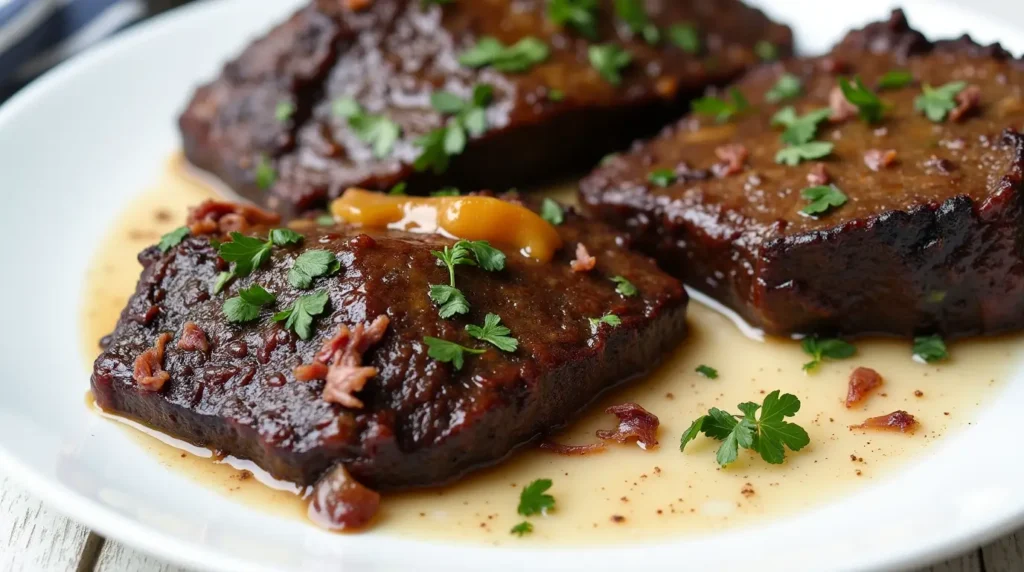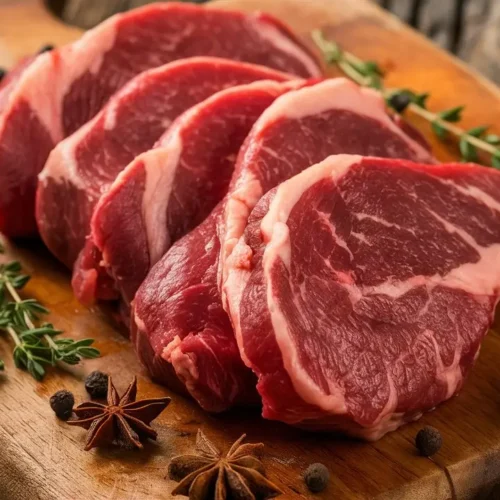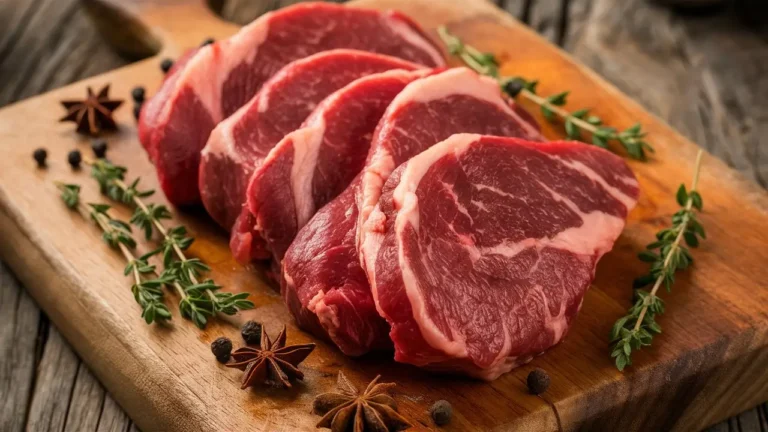Beef cheek meat might not be the first cut you grab at the butcher, but once you try them slow-cooked, you’ll wonder why they aren’t more popular. This underrated cut comes from the facial muscle of the cow, which gets a workout from chewing—making it dense with connective tissue. But that’s actually a good thing. When cooked low and slow, all that collagen melts into gelatin, turning the meat into something unbelievably tender, almost like the best pot roast you’ve ever had—but richer and more flavorful.
Why This Recipe Works
- Deep, Complex Flavor: Braising in red wine and aromatics builds layers of savory, slightly sweet, and earthy notes.
- Foolproof Method: Unlike quick-cooking steaks, beef cheeks are forgiving—the longer they cook, the better they get.
- Restaurant-Quality at Home: This is the kind of dish you’d pay top dollar for at a fancy bistro, but it’s surprisingly simple to make yourself.
Perfect for Special Dinners (or Just Because)
While this dish takes time, most of it is hands-off. It’s ideal for:
- Weekend projects: Let it simmer while you relax.
- Dinner parties: Impress guests without stress—it reheats beautifully.
- Meal prep: The flavors deepen overnight, making leftovers even better.
A Cut Above the Rest
Compared to pricier cuts like short ribs or filet mignon, beef cheeks deliver more flavor for less money. They’re a staple in many global cuisines (think Italian guanciale or Mexican barbacoa), and once you master this recipe, you’ll find endless ways to use them—from pasta to tacos to shepherd’s pie.
Key Takeaway: Don’t let the unusual cut intimidate you. With patience and a good pot, beef cheeks become a luxurious, comforting dish that’s worth the wait.
Why Beef Cheeks Deserve a Spot in Your Kitchen
Beef cheeks offer remarkable advantages that make them stand out from more common cuts of meat. Here’s why they should become a staple in your cooking repertoire:

1. Unparalleled Texture
- The high collagen content transforms into silky gelatin during cooking
- Results in meat so tender it literally falls apart with gentle pressure
- Creates a luxurious mouthfeel similar to premium cuts like short ribs
2. Budget-Friendly Luxury
- Typically 30-50% cheaper than comparable premium cuts
- Delivers restaurant-quality results at home-cooked prices
- Excellent value for the flavor and texture you receive
3. Flavor Absorption Superstar
- Acts like a flavor sponge for braising liquids
- Absorbs and enhances wine, broth, and aromatics exceptionally well
- Develops deeper, more complex flavors than leaner cuts
4. Versatile Foundation
- Perfect for global dishes: French daube, Italian ragu, Mexican barbacoa
- Adaptable to various cooking methods: braising, slow cooking, pressure cooking
- Works in multiple formats: shreds for tacos, chunks for stews, whole for plating
5. Forgiving Nature
- Hard to overcook – becomes more tender with longer cooking
- Mistakes in timing are less critical than with premium steaks
- Maintains quality when reheated, often improving in flavor
6. Nutritional Benefits
- Rich in collagen, which supports joint health
- Contains beneficial amino acids like glycine and proline
- Provides iron and protein in highly bioavailable forms
Pro Tip: Look for cheeks with even marbling and minimal silverskin. The best specimens will have a deep red color with thin streaks of fat running through the muscle.
Ingredients Breakdown: Building Layers of Flavor
The magic of this beef cheek recipe lies in its carefully selected ingredients, each playing a specific role in creating the final masterpiece. Here’s your complete shopping list with expert insights:
The Star: Beef Cheeks (2-2.5 lbs)
- Look for evenly sized pieces (about 1-inch thick) for consistent cooking
- Well-trimmed but with some fat marbling remaining
- Alternative sources if unavailable: Asian or Latin markets often carry them fresh
Aromatic Foundation
- 2 yellow onions: Sweet variety works best for caramelization
- 3 carrots: Adds natural sweetness and body to the sauce
- 4 garlic cloves: Fresh, plump cloves preferred over pre-minced
- 2 tbsp tomato paste: Use double-concentrated for deeper flavor
Liquid Components
- 1 bottle (750ml) dry red wine: Cabernet Sauvignon or Merlot recommended
- 4 cups beef stock: Homemade or quality store-bought (low sodium)
- 2 tbsp balsamic vinegar: The secret ingredient for balancing richness
Herbs & Spices
- 3 fresh thyme sprigs: Or 1 tsp dried thyme
- 2 bay leaves: Turkish variety preferred over California
- 1 tsp black peppercorns: Whole, for more controlled flavor release
- 1 star anise: Optional but adds incredible depth
Cooking Essentials
- 3 tbsp olive oil: For optimal searing
- Kosher salt: About 2 tsp total (adjust to taste)
- Flour for dusting: About ¼ cup (optional for thicker sauce)
Why This Combination Works:
The ingredients create a perfect balance:
- Acidity from wine and vinegar cuts through richness
- Umami from stock and tomato paste deepens flavor
- Sweetness from carrots and onions rounds out the profile
- Herbs add aromatic complexity without overpowering
Pro Tip: For best results, prep all ingredients before starting (mise en place). This ensures proper cooking times and prevents burning aromatics while you chop.
Step-by-Step Cooking Instructions: Mastering Beef Cheek Perfection
Follow this carefully tested method to transform tough beef cheeks into buttery-soft, flavor-packed perfection:
1. Prep Work (15 minutes)
- Remove beef cheeks from fridge 30 minutes before cooking
- Pat completely dry with paper towels (crucial for proper searing)
- Season generously on all sides with kosher salt (about 1 tsp total)
- Optional: Lightly dust with flour for enhanced browning
2. Searing the Meat (8-10 minutes)
- Heat Dutch oven over medium-high heat for 2 minutes
- Add 2 tbsp olive oil until shimmering but not smoking
- Sear cheeks in batches (don’t crowd!) for 3-4 minutes per side
- Develop deep brown crust – this builds flavor foundations
- Transfer to plate, reserving juices in pot
3. Building the Base (7 minutes)
- Reduce heat to medium, add 1 tbsp more oil if needed
- Cook onions and carrots for 5 minutes until softened
- Add garlic and tomato paste, cook 1 minute until fragrant
- Deglaze with 1 cup wine, scraping up all browned bits
4. The Braise (3.5-4 hours)
- Return beef cheeks to pot, nestling into vegetables
- Add remaining wine, stock, and all herbs/spices
- Liquid should cover meat about 2/3 of the way up
- Bring to gentle simmer, then cover and transfer to oven
- Cook at 300°F (150°C) for 3 hours undisturbed
5. Final Touches (20 minutes)
- Check for doneness – meat should yield easily to fork
- Transfer cheeks to serving platter, tent with foil
- Strain braising liquid, skim fat, then reduce by 1/3
- Adjust seasoning with salt, pepper, and vinegar
Critical Timing Notes:
- Start checking doneness at 2.5 hour mark
- Can extend cook time to 4 hours for ultra-tender results
- If sauce is too thin, thicken with cornstarch slurry
Visual Cues for Success:
- Properly seared: Deep mahogany crust on meat
- Perfect doneness: Meat separates with gentle fork pressure
- Ideal sauce consistency: Coats the back of a spoon
Pro Tip: For deeper flavor, refrigerate overnight after cooking – the flavors intensify remarkably when reheated the next day. Simply skim solidified fat before gently rewarming.
Pro Tips and Variations: Elevate Your Beef Cheek Mastery
Take your beef cheeks from great to extraordinary with these professional techniques and creative adaptations:
Essential Pro Techniques
- The Double Sear Method
- After initial sear, refrigerate meat for 1 hour
- Re-sear just before braising for an intensified crust
- Flavor Infusion Hack
- Wrap herbs/spices in cheesecloth for easy removal
- Add dried mushrooms (porcini or shiitake) for umami boost
- Perfect Texture Secrets
- For ultra-silky results, cook at 275°F (135°C) for 5-6 hours
- Rest meat in strained liquid for 30 minutes before serving
Game-Changing Variations
Global Flavor Twists:
- French Style: Add 1/4 cup cognac + orange zest
- Mexican Inspired: Substitute beer for wine, add chipotle + cumin
- Asian Fusion: Use star anise, cinnamon, and swap stock for pho broth
Cooking Method Alternatives:
- Slow Cooker Adaptation
- Complete searing and deglazing steps on stove
- Transfer to slow cooker, cook on LOW 8-9 hours
- Pressure Cooker Version
- Reduce liquid by 1/3 (only 2 cups stock needed)
- Cook at high pressure for 75 minutes
- Natural release for 15 minutes
- Sous Vide Option
- Season and vacuum seal with aromatics
- 185°F (85°C) for 24 hours
- Quick sear before serving
Troubleshooting Guide
- Too Tough? Continue cooking in 30-minute increments
- Too Salty? Add peeled raw potato to absorb excess salt
- Sauce Too Thin? Reduce further or add 1 tsp cornstarch slurry
- Fat Layer Too Thick? Chill and remove solidified fat
Serving Suggestions: Elevating Your Beef Cheek Presentation
Transform your tender beef cheeks into stunning culinary creations with these professional plating ideas and accompaniments:
1. Classic Elegant Presentation
- Centerpiece: Place whole beef cheek on warm plate
- Sauce: Pool reduced braising liquid around meat
- Garnish: Microgreens + grated horseradish
- Pairing: Creamy celery root purée + glazed baby carrots
- Pro Tip: Use ring mold for perfect purée presentation
2. Comfort Food Style
- Base: Heap over ultra-creamy mascarpone polenta
- Topping: Crispy fried shallots + parsley gremolata
- Side: Roasted Brussels sprouts with pancetta
- Sauce: Extra braising liquid served in small pitcher
3. Modern Deconstructed Approach
- Shredded: Flake meat into large chunks
- Components:
- Smear of carrot purée
- Crispy potato galette
- Quick-pickled red onions
- Drizzle: Reduced sauce in artistic strokes
4. Global Inspirations
- Italian: Toss with pappardelle pasta + gremolata
- Mexican: Serve in warm corn tortillas with radish slaw
- French: Pair with duchess potatoes + haricots verts
- Asian: Serve with jasmine rice + bok choy
5. Special Occasion Plating
- First Layer: Celery root and potato mash
- Middle: Beef cheek (whole or sliced)
- Top: Crispy fried leeks
- Sauce: Red wine reduction dots
- Final Touch: Edible flowers (nasturtiums work well)
Temperature Control Tips:
- Warm plates in 200°F oven for 5 minutes before plating
- Sauce should be napé consistency (coats spoon thickly)
- Meat resting time: 7-10 minutes before slicing
Wine Pairings:
- Best Match: Aged Cabernet Franc or Malbec
- Alternative: Belgian-style Dubbel beer
- Non-Alcoholic: Blackcurrant and star anise infused tea
Leftover Makeovers:
- Beef Cheek Ravioli: Mix shredded meat with ricotta filling
- Shepherd’s Pie: Top with parsnip mash
- Tacos: Quick fry with cumin and chipotle
- Hash: Breakfast version with fried eggs
Final Presentation Tip: Always wipe plate edges with damp cloth for clean, professional look before serving.
Conclusion: Why This Beef Cheek Recipe Belongs in Your Repertoire
After guiding you through every step – from selecting the perfect cheeks to stunning presentation – it’s clear why this cut deserves your attention. Here’s why this recipe will become one of your most-requested dishes:
1. Transformational Cooking at Its Best
- Witness the magic of tough connective tissue turning to silk
- Experience professional-level results with home kitchen techniques
- Master a technique that applies to countless other tough cuts
2. Maximum Flavor with Minimum Fuss
- Hands-on time under 45 minutes for an impressive centerpiece
- Most cooking happens unattended in the oven
- Makes your kitchen smell incredible for hours
3. The Ultimate Make-Ahead Dish
- Flavor improves over 1-3 days in refrigerator
- Freezes beautifully for up to 3 months
- Reheats perfectly for stress-free entertaining
4. Endless Creative Possibilities
- Foundation recipe for countless global variations
- Adaptable to any season or occasion
- Works with nearly any cooking method you prefer
5. Teaches Fundamental Skills
- Perfect your searing technique
- Master sauce reduction principles
- Learn proper braising fundamentals
Final Thought: In our fast-food world, this recipe celebrates the forgotten art of slow cooking. The patience required yields dividends in flavor and texture you simply can’t rush. Whether serving to guests or treating yourself, beef cheeks offer one of the most rewarding cooking experiences – transforming an inexpensive, overlooked cut into something truly extraordinary.
FAQs: Your Beef Cheek Questions Answered
1. What exactly is Beef cheek meat?
Beef cheeks are the facial muscles from cattle that contain:
- High collagen content (breaks down into gelatin when slow-cooked)
- Intense beefy flavor from constant muscle use
- Marbled fat pockets that melt during cooking
- Typically sold as 1-2 inch thick, palm-sized portions
Butcher’s Tip: Ask for “whole beef cheeks” if you want to trim them yourself for better control over fat content.
2. Where can I buy beef cheeks?
- Specialty butchers: Often kept in back, so ask specifically
- International markets: Latin (labeled “cachete”), Asian, or European butchers
- Online retailers: Several premium meat websites ship nationwide
- Farmers markets: From grass-fed beef producers
Alternative Sources: Check with local restaurants that serve barbacoa – they may share their supplier.
3. Can I substitute other cuts if I can’t find beef cheeks?
Best Alternatives:
- Short ribs (adjust cook time to 2.5-3 hours)
- Chuck roast (cut into large 3-inch cubes)
- Oxtail (longer cook time up to 5 hours)
- Brisket point (similar collagen content)
Avoid These Substitutes:
✖️ Lean cuts like sirloin or round
✖️ Quick-cooking steaks
✖️ Pre-ground beef
4. How do I know when beef cheeks are properly cooked?
Doneness Indicators:
- Meat pulls apart easily with forks (no knife needed)
- Internal temperature of 195-205°F (90-96°C)
- Gelatinous texture when pressed with finger
- Visible strands separating in the grain
Common Mistake: Undercooking results in chewiness – err on the side of longer cooking.
5. Can I prepare beef cheeks in advance?
Make-Ahead Guide:
- 3 days ahead: Cook completely, store in braising liquid
- 1 month ahead: Freeze cooked portions with sauce
- Day of serving: Reheat gently in 300°F (150°C) oven for 45 minutes
Pro Tip: The flavor improves significantly after 24-48 hours of refrigeration.
6. What’s the best way to store and reheat leftovers?
Storage Protocol:
- Cool completely in braising liquid
- Transfer to airtight container with sauce
- Refrigerate up to 5 days or freeze 3 months
Reheating Methods:
- Oven: 325°F (160°C) for 25-30 minutes
- Sous vide: 140°F (60°C) for 1 hour
- Stovetop: Low heat with added broth to prevent drying
7. Why did my beef cheeks turn out dry/tough?
Common Causes:
- Insufficient cooking time (minimum 3 hours required)
- Cooked at too high temperature
- Not enough braising liquid
- Over-trimmed before cooking (removed necessary fat)
Solution: Return to liquid and continue cooking in 30-minute increments.
8. Are beef cheeks healthy?
Nutritional Highlights:
✔️ High in collagen (supports joints/skin)
✔️ Rich in iron and zinc
✔️ Good source of B vitamins
✔️ Contains beneficial fatty acids
Braised Beef Cheeks Recipe
Fall-apart tender beef cheeks slow-cooked in rich red wine sauce with aromatic vegetables – an impressive yet simple dish perfect for special occasions or cozy dinners.
Recipe Details
| Prep Time | Cook Time | Total Time | Servings | Calories |
|---|---|---|---|---|
| 20 minutes | 3.5 hours | 4 hours | 4-6 | 520 kcal/serving |
Nutrition Information (Per Serving)
| Calories | Fat | Protein | Carbs | Fiber | Sugar |
|---|---|---|---|---|---|
| 520 kcal | 28g | 42g | 12g | 2g | 4g |
Additional Nutrients:
- Cholesterol: 140mg
- Sodium: 680mg
- Iron: 5mg (28% DV)
- Vitamin A: 120% DV
- Calcium: 6% DV
Recipe Categories
| Course | Cuisine | Diet | Method | Keyword | Skill Level |
|---|---|---|---|---|---|
| Main Course | French-inspired | Gluten-Free, Keto-friendly | Braising | Beef Cheeks, Red Wine Braise, Slow-Cooked Beef | Intermediate |
Key Highlights
✔️ Restaurant-quality results at home
✔️ Make-ahead friendly – tastes better next day
✔️ Versatile for tacos, pasta, or standalone
✔️ Budget-friendly premium dining experience
Pro Tip: For best texture, cook until meat reaches 203°F (95°C) internal temperature.

Buche Meat Recipes for Delicious Dishes
Ingredients
- The Star: Beef Cheeks 2-2.5 lbs
- Look for evenly sized pieces about 1-inch thick for consistent cooking
- Well-trimmed but with some fat marbling remaining
- Alternative sources if unavailable: Asian or Latin markets often carry them fresh
- Aromatic Foundation
- 2 yellow onions: Sweet variety works best for caramelization
- 3 carrots: Adds natural sweetness and body to the sauce
- 4 garlic cloves: Fresh plump cloves preferred over pre-minced
- 2 tbsp tomato paste: Use double-concentrated for deeper flavor
- Liquid Components
- 1 bottle 750ml dry red wine: Cabernet Sauvignon or Merlot recommended
- 4 cups beef stock: Homemade or quality store-bought low sodium
- 2 tbsp balsamic vinegar: The secret ingredient for balancing richness
- Herbs & Spices
- 3 fresh thyme sprigs: Or 1 tsp dried thyme
- 2 bay leaves: Turkish variety preferred over California
- 1 tsp black peppercorns: Whole for more controlled flavor release
- 1 star anise: Optional but adds incredible depth
- Cooking Essentials
- 3 tbsp olive oil: For optimal searing
- Kosher salt: About 2 tsp total adjust to taste
- Flour for dusting: About ¼ cup optional for thicker sauce
Instructions
- Prep Work (15 minutes)
- Remove beef cheeks from fridge 30 minutes before cooking
- Pat completely dry with paper towels (crucial for proper searing)
- Season generously on all sides with kosher salt (about 1 tsp total)
- Optional: Lightly dust with flour for enhanced browning
- Searing the Meat (8-10 minutes)
- Heat Dutch oven over medium-high heat for 2 minutes
- Add 2 tbsp olive oil until shimmering but not smoking
- Sear cheeks in batches (don’t crowd!) for 3-4 minutes per side
- Develop deep brown crust – this builds flavor foundations
- Transfer to plate, reserving juices in pot
- Building the Base (7 minutes)
- Reduce heat to medium, add 1 tbsp more oil if needed
- Cook onions and carrots for 5 minutes until softened
- Add garlic and tomato paste, cook 1 minute until fragrant
- Deglaze with 1 cup wine, scraping up all browned bits
- The Braise (3.5-4 hours)
- Return beef cheeks to pot, nestling into vegetables
- Add remaining wine, stock, and all herbs/spices
- Liquid should cover meat about 2/3 of the way up
- Bring to gentle simmer, then cover and transfer to oven
- Cook at 300°F (150°C) for 3 hours undisturbed
- Final Touches (20 minutes)
- Check for doneness – meat should yield easily to fork
- Transfer cheeks to serving platter, tent with foil
- Strain braising liquid, skim fat, then reduce by 1/3
- Adjust seasoning with salt, pepper, and vinegar

